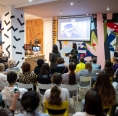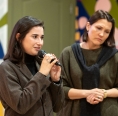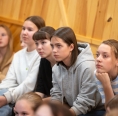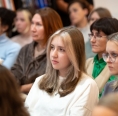-
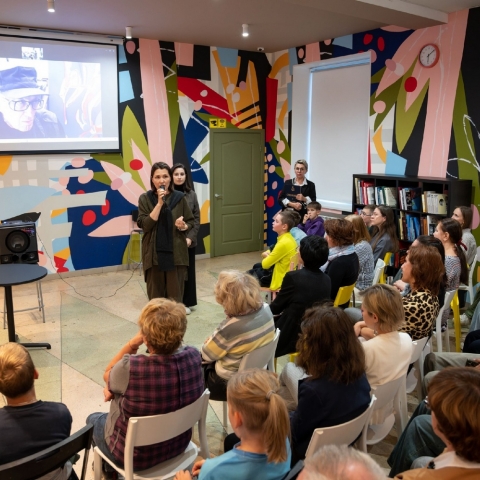
COMPETITION. EXHIBITION. RESEARCH
-
Address:
-
Partners:
Mikhail Shemyakin, an artist, sculptor, historian, and producer of ballet and dramatic performances, along with his colleagues, met with the residents of the Satka District to discuss the ‘Hand in Art’ competition, which is being held with the support of the Magnezit Group.
The meeting took place on October 7 at the Art Satka Creative Public Space in a press conference format. Mikhail Mikhailovich communicated with the audience via video conference, while Olga Sazonova, General Director of the Mikhail Shemyakin Center and a Candidate of Art Sciences, and Ekaterina Topler, Head of the Center’s PR Department, arrived in Satka. They spoke about the competition and answered questions from those present.
“Mikhail Mikhailovich, what role does the theme of ‘Hand’ play in your research, and what kind of works are you expecting from the participants?” asks Ekaterina Topler, posing the first question.
“This theme is one of the most important in my research, which I have been conducting for 60 years. Great attention has been given to the hand since ancient times. Masters from different countries and various ethnic backgrounds created works depicting the hand. There are so many such works that the research will continue for a long time. These include sculpture, graphics, painting, and video art,” replies Mikhail Shemyakin. “And what do our hands, palms, and fingers mean to us? They represent both the language of the deaf and the language of those fortunate enough to hear; in communication, we cannot do without gestures. Especially, the Italians. I have some humorous drawings dedicated to Italian hands, which are constantly expressing something. I believe that the theme of the competition and the upcoming exhibition, planned as a result of this competition in Satka, will resonate strongly with many people. It will give artists the opportunity to reinterpret this theme in new ways and approach the materials and techniques with fresh ideas. I believe this will be a very interesting aspect, and I am glad that the event will take place in your town. Today, small towns are competing with Moscow and Saint Petersburg in their experiments in exhibitions, documentary filmmaking, and other art forms, and sometimes they even create a sensation.”
“I should add that the competition is being held as part of the Mikhail Shemyakin Imaginary Museum Project. We are accepting applications from artists, sculptors, designers, and other creators until November 1. On November 27, we will open the ‘Hand in Art’ exhibition at the Magnezit Palace of Culture,” continued Olga Sazonova, curator of the Mikhail Shemyakin Imaginary Museum Project. “Perhaps your works will be displayed alongside those of participants from Moscow, Saint Petersburg, and Belarus. We have already received applications from various cities across both countries. Additionally, there are works by Mikhail Shemyakin that he created with one of his students over the course of ten years, also exploring the theme of ‘Hand’. Alongside these, the creativity of Satka authors will also be showcased, which is both wonderful and an honor!”
Additionally, Olga emphasized that the project includes a substantial educational component and that she invited researchers and analysts not only from the field of visual arts but also from music, literature, theater, and other visual domains. The reports will be part of the program for the round table that will take place following the exhibition. Workshops for the younger generation will also be organized as part of the exhibition.
“Since the project was previously showcased in several cities across Russia and abroad, how has it transformed before arriving in Satka? Perhaps it has been supplemented with new elements?” asked the participants of the meeting.
“It is constantly expanding. New materials are emerging, and new works by artists are being created—an immense and fascinating expansion of the project is underway,” explains Mikhail Mikhailovich. “I also explore the theme of the ‘Circle,’ referring to it as an ‘endless circle,’ because artists continue to produce a multitude of works based on this seemingly simple figure, and they will do so until the end of the century. Our research laboratory, much like an enchanted one, is constantly engaged with this theme, as well as with the hand, both of which are remarkably unique and significant.
“Sixty years ago, when you began your research, what was the main reason behind it, and what motivated you to study the theme of the ‘Hand’?” asks the next question.
“It all started a long time ago, back when I lived in the Soviet Union. You understand that, due to certain ideological reasons, publishing books on modern art was prohibited, and there were very few books on ancient art. We searched in libraries, photographed the works we liked with our small cameras, and then glued black-and-white prints into our notebooks. We asked to have books brought to us from the distant halls of the Academy of Arts (and back then they were marked according to their level of danger to readers; as far as I remember, the marks were a circle, a square, or a triangle, and the books were allowed to be used only by professors). What they were afraid of, I do not know. However, the interest only grew, much like that towards forbidden fruit. We wanted to understand, for example, where we could go from African art, as Picasso or Modigliani did, like many European artists. We tried to find our own path, to extract something from those small images gathered in our notebooks for the further development of our art. When I was exiled from the Soviet Union and came to the West, I was shocked by the number of books available. I began to carefully collect editions on topics that resonated with me, comparing and analyzing them. Then I decided that it would be interesting to expand this collection and make it accessible to young artists. Thus, my work transformed into a large research laboratory. Following the example of Malraux, who formulated the concept of an ‘imaginary museum,’ I created my own museum.”
By the way, according to the project curator, a sheet dated 1963, when Mikhail Shemyakin began his research, will be exhibited in Satka. The meeting continued with interest in the artist’s current projects.
“When people enter my workshop, the first question is, ‘How many hours do you sleep and how many clones do you have?’” continues Mikhail Shemyakin, responding to a question from Vera Moshkina, a teacher at the Yu. A. Rozum Children’s School of Arts No. 1. “It is difficult to imagine that one person is engaged in sculpture, research, and the Russian language. Perhaps you know that I have been trying to preserve the vanishing Russian language for many years. English words are being introduced, which is unnecessary since the Russian language is so rich! That is why I study Russian dialects to preserve a unique and humorous language that designates objects, phenomena, people, and more. For this purpose, we, together with the AST publishing house, are preparing new alphabets that include words from various regions of old Russia, and I complement them with drawings. As a result, humorous words and images emerge that children can use, for example, as teasing rhymes (referring to words designating a clumsy or awkward person). I work with children’s magazines. For instance, in ‘Kostyor,’ a special centerfold for children titled ‘Words as Riddles and Riddles as Words’ was published for a year. This is a significant theme in my life and art that I continue to pursue. What else? I am finishing the book titled ‘Six Years of Teaching,’ which focuses on my teaching system that differs from the conventional approach. I have received a proposal to implement it in all art institutions. This book discusses how to nurture young artists. I am also writing the second volume of my autobiography, ‘Life Abroad.’ The first volume has been published; if you’re aware, it’s titled ‘Life Before Exile’. Additionally, I am preparing a large series of works using a new technique: I photograph various types of waste and then draw images based on the photographs. There’s no need to invent anything; you simply need to see correctly what is already present. I am also working on the musical ‘Freddy the Rat,’ collaborating with American composers. The main character will be a plump rat, while the Nutcracker and Mashenka will take a back seat. I have so many projects that it is even difficult to recall what I am currently working on…”
Furthermore, the participants of the meeting expressed their gratitude to the artist for ensuring his works reach remote areas, reminiscing about exhibitions that were previously held in the South Ural region.
OUR REFERENCE:
The application period for the ‘Hand in Art’ competition will continue until November 1. Submissions should be sent to art@mihfond.ru. Details and guidelines can be found in the ‘Competitions’ section on the official website of the Mikhail Shemyakin Center, as well as in the broadcast of the press conference by TASS dedicated to the launch of the ‘Hand in Art’ competition.
Project Partner: Magnezit Group
Source: Magnezitovets. Photograph: Vasily Maksimov.
-
26.08 - 26.08
DIARY OF THE THIRD INDUSTRIAL BIENNALE
-
28.11 - 28.11
MY SATKA FESTIVAL WINS THE CONTEST OF CORPORATE VOLUNTEER PROJECTS
-
13.10 - 15.10
COOPERATION WITH VGIBL NAMED AFTER M.I. RUDOMINO

